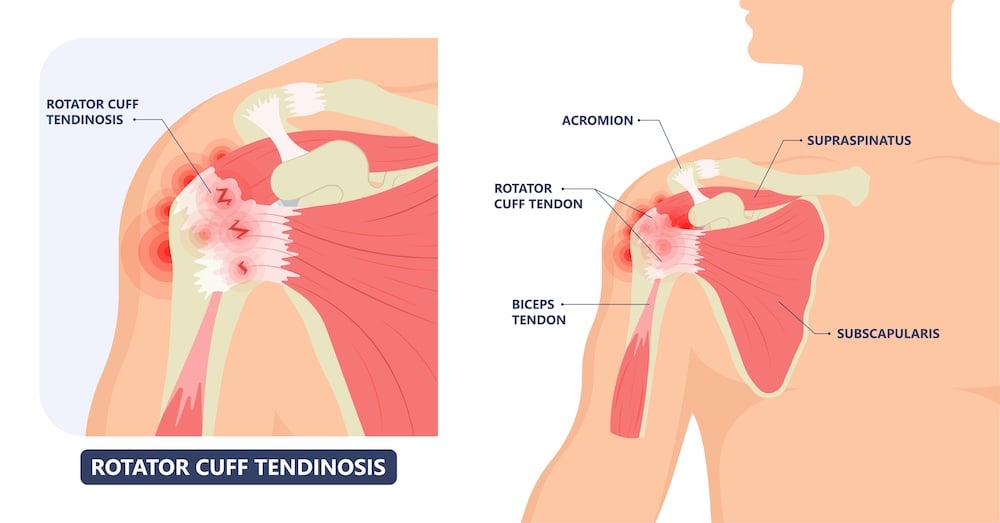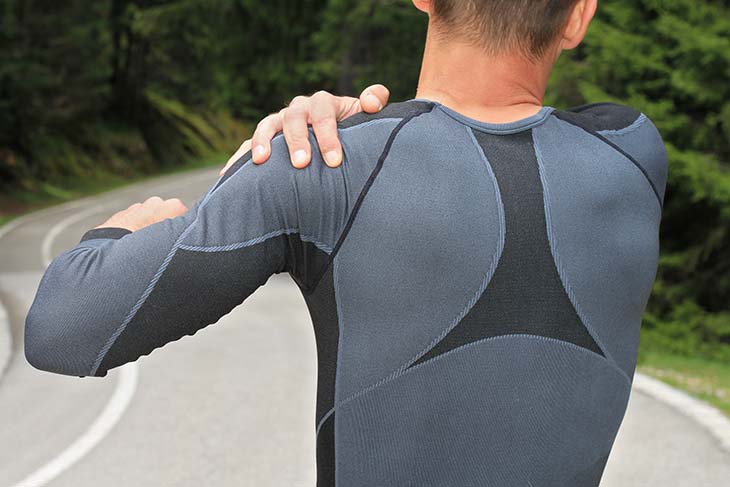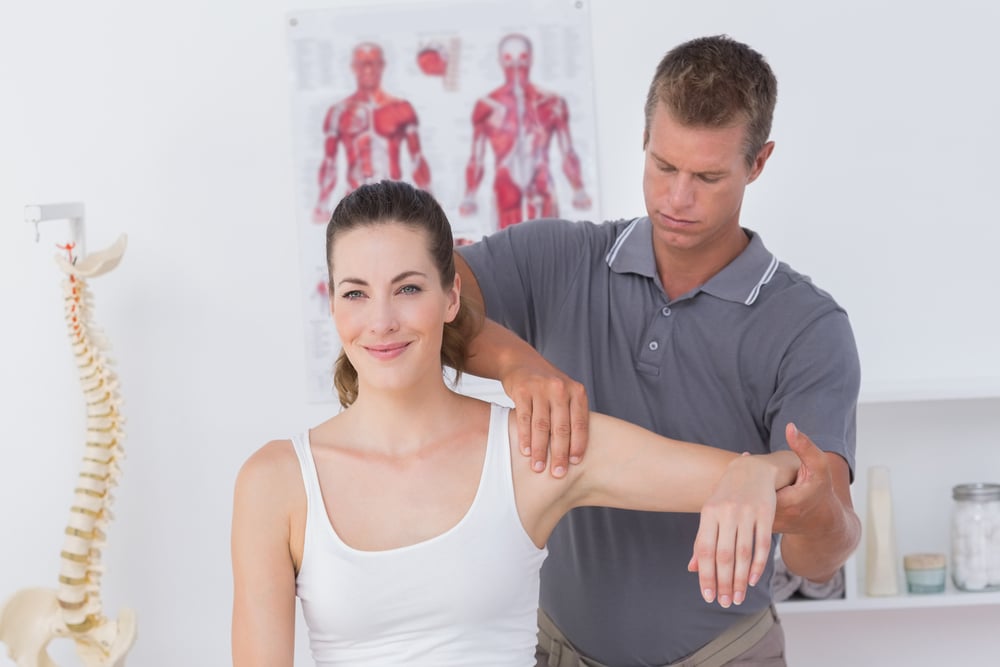3 Common Types of Shoulder Pain
5 min read

Shoulders are complex combos of bones, joints, tendons, and muscles that allow your arms to move up and down, forward and backward, and in circles. Because it’s so complex and highly used (and overused), shoulders are prone to instability.
Shoulder pain can stop your normal daily activities in your tracks. Most shoulder pain is a result of a few different issues. These include:
- Rotator cuff injury
- Inflammation (tendinitis or bursitis)
- Tendon tear
- Arthritis
- A broken bone
- Infections
- Or nerve injuries
A proper diagnosis is important to determine the best treatment for you. Your doctor may order X-rays to look for bone damage, an MRI or ultrasound to identify soft tissue injuries and torn tendons or ligaments, an electromyogram to evaluate nerve function, or arthroscopy to look inside the joint for injuries not seen with the above methods.
Chiropractic Care for Shoulder Pain
Depending on the injury, chiropractic care can be helpful for shoulder pain relief and improving mobility and flexibility. For some patients this might be before surgery is needed, and for others chiropractic care can help you return sooner to your regular activities.
Cold laser therapy is an FDA-approved, low-intensity laser treatment that reduces inflammation, swelling and improves blood flow to promote healing. Massage and stretching exercises can increase blood flow to the injured area, as well as improve shoulder joint flexibility.
Common Types of Shoulder Injuries
Three of the most common types of shoulder injuries are rotator cuff injuries, osteoarthritis, and tendonitis. Let’s take a closer look at the causes, treatment, and prevention of each of these.
1. Rotator Cuff Injuries
Your shoulder includes an upper arm bone, collarbone, and shoulder blade. The upper arm bone fits into a round socket in your shoulder blade. Muscles and tendons (called the rotator cuff) keep the arm bone in the shoulder socket. This ball and socket joint makes it possible for your arm to move in all directions.
Rotator cuff injuries can be caused by:
- Aging brings normal degeneration of the joint due to years of wear and tear. Tendon tears are most common past age 60.
- Repetitive motions, especially overhead movements, that cause damage over time to the rotator cuff.
- Injury or trauma can partially or completely force the arm bone out of the shoulder socket or cause a tear in the tendon. This could happen by falling down on an outstretched arm.
- Less common is a family history of rotator cuff injuries.
Rotator cuff injury symptoms can include:
- Pain
- Swelling
- Weakness
- Inflammation
- Dull aching deep inside the shoulder
- Crepitus (cracking or popping) when moving
Symptoms of a tendon tear include pop or catching sensation with certain movements or a loose feeling in the shoulder as though it’s “slipping.”
Treatment may be as simple as taking over-the-counter, pain-relieving medications for a few days and reducing activities that cause pain. With complex or severe injuries, you may need a physical therapist to teach you specific exercises to strengthen the joint and increase flexibility.
Without treatment, which is typically surgery, for severe rotator cuff problems, you may have a permanent loss of mobility in the joint or weakness that causes your shoulder joint to continue to deteriorate. Chiropractic care can help reduce pain, inflammation, and speed healing.
Although you may be advised to avoid strenuous activities, it’s important to avoid completely immobilizing your shoulder joint. This can cause the connective tissue within the joint to become tight, inflexible, and thickened (called a “frozen” shoulder).
2. Osteoarthritis of the Shoulder
The most common type of arthritis linked to shoulder pain is osteoarthritis. This “wear and tear” type of arthritis causes pain, swelling, stiffness, and loss of mobility. Over time the cartilage in the shoulder joint wears down, causing the bones to rub against one another when you move.
You’re more likely to develop osteoarthritis in the shoulder if you are:
- Older - typically seen in patients over age 60
- Female - women tend to have more issues with shoulder arthritis than men
- Overweight: extra weight puts more stress on joints; plus, fat produces proteins that can cause joint inflammation
- Had a previous shoulder injury
- Have repeated stress on your shoulder joint
- Have certain metabolic diseases such as diabetes or hemochromatosis (body absorbs too much iron)
- Have a family history of osteoarthritis
- Were born with a bones, joints, or cartilage deformity
The primary symptoms of shoulder osteoarthritis are pain and loss of flexibility. While the pain develops slowly, it can get worse – and usually does – over time.
Treatment for shoulder arthritis focuses on maintaining mobility and reducing pain. The cartilage can’t regenerate. This means the primary focus for most patients is to manage the pain.
To avoid the pain, it’s common to try to limit shoulder movement. This is a mistake because it only stiffens and reduces flexibility in the shoulder. We can show you movements that will help you keep mobility in the joint and can suggest other chiropractic treatments to maintain strength and flexibility.
3. Tendonitis of the Shoulder and Rotator Cuff
Tendonitis is inflammation or irritation of a tendon. Your tendons are thick cords of fiber that attach muscle to bone. The shoulder joint is a common site for tendonitis. There are several different tendons in the shoulder, but the four most common tendons that are associated with tendonitis affect the four tendons located in the rotator cuff. From the front to the back, these are:
- subscapularis
- supraspinatus
- infraspinatus
- teres minor

Symptoms of shoulder tendonitis include:
- Dull ache, mild pain and swelling, and tenderness around the joint
- Loss of strength and range of motion in the arm
- Stiffness and restricted joint movement
- Swelling
- Localized burning pain that gets worse during and after activity
The cause of tendonitis in the shoulder joint is:
- Long-term stress placed on tendons by repetitive movement, usually due to a sport or job task. Chronic tendonitis (also called tendinosis) can be caused by arthritis or long-term stress that comes from aging or lifestyle habits.
- Injury or trauma to the joint, such as a vehicle accident or fall. This damage to the tissue is considered an acute injury.
Treatment should focus on improving mobility and reducing discomfort. Without proper treatment, tendinitis can increase your risk of a tendon rupture, likely requiring surgery to repair. Tendonitis that persists for several months can cause other changes in the tendon that includes abnormal growth of new blood vessels.
Start treatment at home with these steps:
- Use proper form or technique when playing sports. Remember to stretch after a sports workout when your muscles are warmed up. This will increase joint flexibility.
- Properly align your work desk, chair, keyboard, and computer screen to reduce stress on your joints.
- Rest your shoulder for several days.
- Try cold or hot packs several times a day.
- Consider chiropractic care or physical therapy if symptoms don’t improve in a few days.
Reach out to Village Chiropractic in The Woodlands for Shoulder Pain Relief
Oftentimes there are simple things you can do to help your shoulder pain at home. But chiropractic care before and/or after surgery or other shoulder pain treatments can help you gain your mobility and strength back much quicker.
Set up an appointment with one of our trained chiropractors who can help create a plan for you.
More from Our Blog on This Topic
3 min read
4 min read





